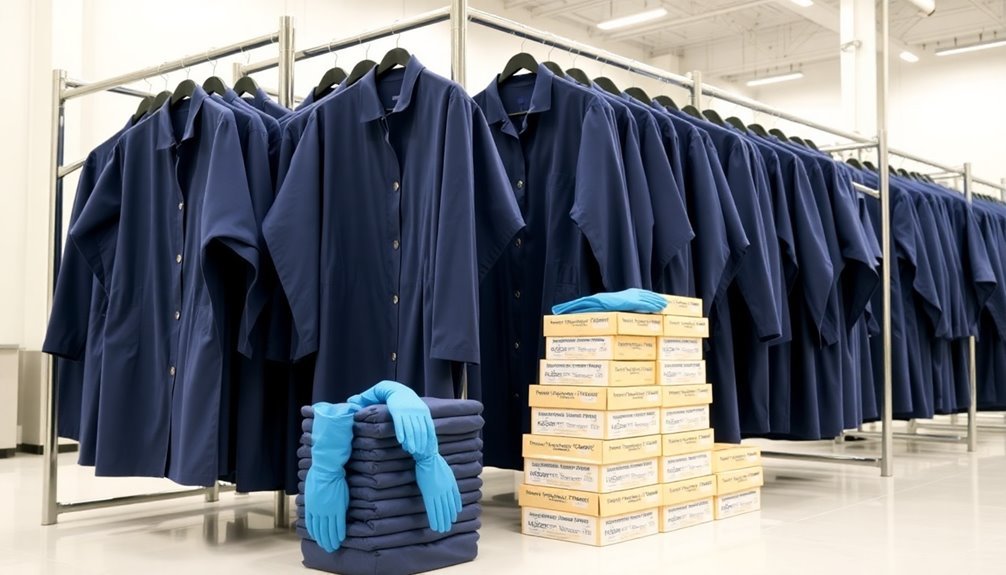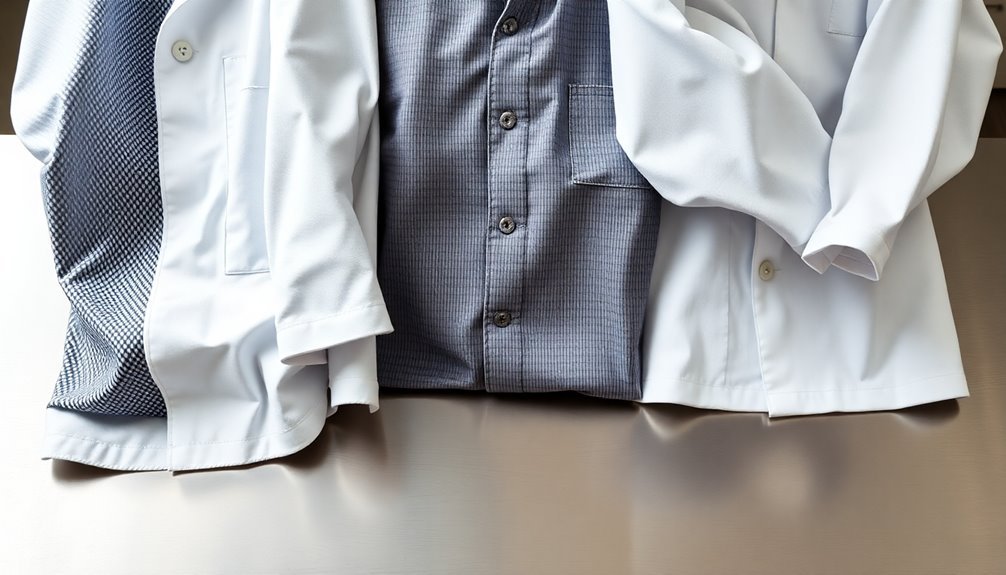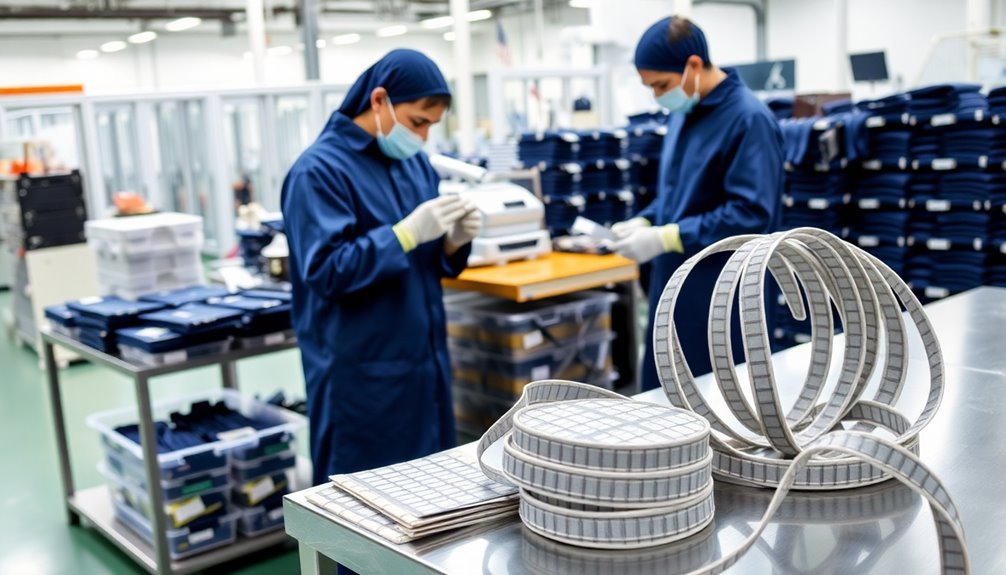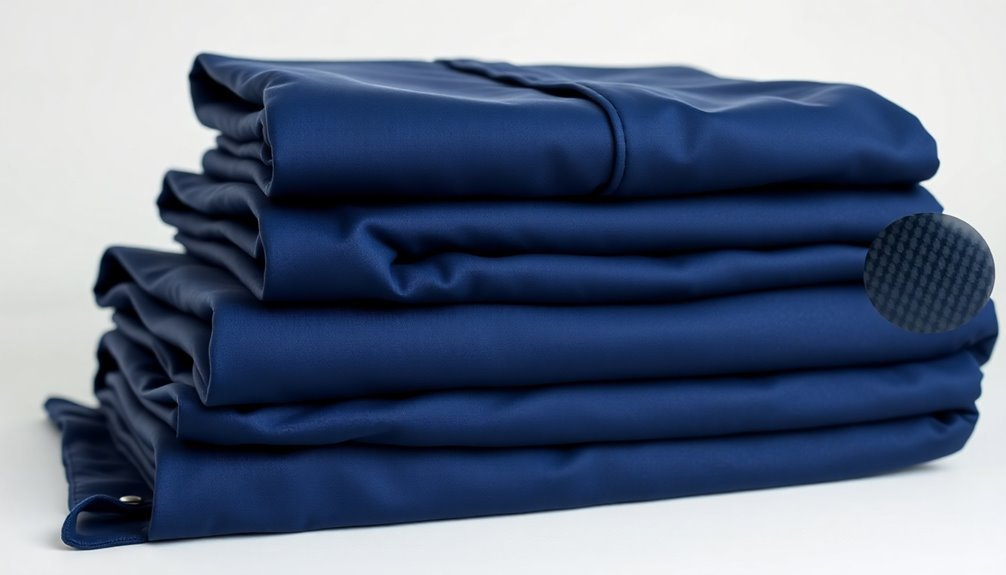You'll find the best bulk deals on static-safe workwear through verified suppliers offering discounts of up to 90% on orders over 100 units, with prices ranging from $1.10 to $22.90 per piece. Leading manufacturers like 3M and DuPont provide customizable options including company logos, multiple fabric types, and different styles to meet your specific industry needs. When purchasing, make certain the garments comply with essential standards like ANSI/ESD S20.20 and IEC 61340 for proper ESD protection. Shipping costs can be as low as $0.09 per piece for bulk orders. The following information will help you make an informed purchasing decision.
Understanding Static-Safe Material Benefits

Static-safe materials revolutionize workplace safety by preventing dangerous electrostatic discharge (ESD) that can damage sensitive equipment and components. When you're working with electronics, pharmaceuticals, or in hazardous environments, these materials serve as your first line of defense against static-related incidents. These materials significantly reduce manufacturing waste and costs by preventing product defects during handling and assembly processes.
You'll find that static-safe workwear offers multiple layers of protection. The materials comply with essential standards like ANSI/ESD S20.20 and IEC 61340, ensuring you're meeting industry requirements while protecting valuable equipment.
The specialized anti-static plastics and conductive fibers work continuously to dissipate static charges safely, preventing buildup that could otherwise lead to costly damage or safety hazards.
Current Market Price Analysis
While protective qualities are paramount, understanding current market dynamics helps you make informed purchasing decisions. You'll find the global anti-static workwear market is expanding rapidly, projected to reach $3.5 billion by 2033 with a 7.2% CAGR. This growth directly impacts your purchasing options and price points across different regions. Leading manufacturers like 3M and DuPont dominate the market with their extensive protective apparel expertise.
| Market Segment | Price Impact | Purchasing Strategy |
|---|---|---|
| North America | Higher costs due to strict regulations | Bulk orders for volume discounts |
| Asia-Pacific | Competitive pricing due to manufacturing hubs | Direct sourcing opportunities |
| Europe | Premium pricing for advanced features | Focus on long-term value |
You'll notice price variations are substantially influenced by material quality and compliance requirements. While initial costs might seem high, especially for smaller operations, you're investing in both safety and regulatory compliance. The market's expansion into healthcare and other sectors is creating more diverse product options, potentially leading to more competitive pricing. When you're planning bulk purchases, consider that emerging economies offer cost-effective sourcing opportunities, though you'll need to carefully balance quality assurance with price advantages.
Top Bulk Order Options

The most cost-effective bulk order options for ESD workwear range from $1.10 to $22.90 per piece, with deeper discounts available for orders exceeding 100 units.
You'll find various customization options, including company logos, multiple fabric types, and different styles like overalls, vests, and jackets to suit your specific industry needs. The garments feature breathable moisture-wicking technology for enhanced comfort during long work shifts.
When you're ordering in bulk, you can choose from polyester and antistatic grid polyester materials that meet international safety standards like ISO and EN11612.
Verified suppliers on platforms like Alibaba offer secure payment options and will send you samples before large orders to guarantee quality and fit. They'll also provide detailed product specifications, including fabric properties and electrostatic dissipation times.
You can expect shipping costs as low as $0.09 per piece for bulk safety glove orders, with worldwide delivery options available. Most suppliers package items individually (1pc/bag) and offer ready-to-ship options with minimal lead times.
For quality assurance, third-party inspection agencies audit these suppliers, guaranteeing you receive certified cleanroom and antistatic garments that meet your industry's high cleanliness standards.
Essential Safety Compliance Standards
Beyond bulk ordering considerations, understanding compliance standards will protect both your workers and equipment. You'll need to guarantee your static-safe workwear meets key international standards like EN ISO 1149 in Europe and ASTM D6413 in the U.S., which specify essential electrostatic properties for protective clothing.
Your facility must comply with OSHA's general duty clause, which requires you to maintain a workplace free from electrostatic hazards. If you're in electronics manufacturing, you'll also need to meet ANSI/ESD S20.20 standards for ESD control. These requirements aren't optional – they're legally mandated safeguards for your operation.
You'll want to verify that your static-safe workwear undergoes proper testing and certification procedures as outlined in ESD TR53. This includes regular testing of resistance values and thorough documentation of compliance. Smart monitoring systems integrated into modern workwear can provide real-time alerts about static buildup levels.
The benefits extend across multiple industries – from preventing damage to sensitive electronic components to reducing static sparks in petrochemical settings. By maintaining strict compliance with these standards, you'll not only protect your workers and equipment but also minimize potential legal liabilities and costly damages to your operation.
Fabric Quality Comparison Guide

Selecting the best fabric for static-safe workwear requires understanding three key material categories: natural fibers, synthetic blends, and specialized ESD fabrics.
Natural fibers like cotton offer inherent anti-static properties and excellent moisture absorption, but you'll need to evaluate their limitations. While cotton performs well in humid conditions, it can lose its protective qualities in dry environments. You'll also need to watch for loose cotton fibers that might contaminate work areas.
Synthetic materials such as polyester and nylon provide consistent performance when treated with anti-static properties. They're enhanced with specialized threads like Resistat or Nega-Stat, and their continuous fiber structure reduces contamination risks. Some manufacturers incorporate carbon-infused materials for superior static dissipation. However, they don't breathe as well as natural fibers.
For maximum protection, look for fabrics that meet EN 1149 standards, ensuring surface resistance below 2.5 x 10^9 ohms. If you're working in ESD-sensitive environments, you'll need garments that meet stricter ESD standards, which test both material and seam performance.
Evaluate fabric weight and shrinkage factors when making bulk purchases, as these affect long-term fit and compliance with safety standards.
Supplier Reliability Assessment Metrics
When you're evaluating static-safe workwear suppliers, you'll want to check their quality certification standards, including ISO 9001 and specific ESD protection certifications.
A supplier's supply chain track record can reveal their consistency in meeting delivery schedules and maintaining product quality across different market conditions. It's crucial to review their defect rates history to understand their commitment to quality control.
You'll also need to examine their financial stability indicators, such as credit ratings and annual revenue growth, to guarantee they can sustain long-term partnerships and maintain reliable product availability.
Quality Certification Standards
Throughout the supply chain, reliable static-safe workwear depends on stringent quality certification standards and supplier performance metrics.
When you're sourcing static-safe workwear in bulk, you'll need to verify that suppliers meet EN 1149-5 standards for static electricity protection and EN ISO 13688 requirements for general protective clothing performance.
You should look for manufacturers with ISO 9001 certification, which confirms they maintain consistent quality management systems. The OEKO-TEX Standard 100 certification's particularly important, as it guarantees your workwear's free from harmful substances.
For additional assurance, check if suppliers have ISO 14001 and ISO 45001 certifications, demonstrating their commitment to environmental and safety standards. Regular safety checks and maintenance are essential requirements specified in the EN ISO 13688 standard to maintain protection levels.
Don't forget to review the supplier's Declaration of Conformity (DoC) and Bureau Veritas certification. These documents prove compliance with required standards.
You'll also want to examine their defect rates and on-time delivery performance. The best suppliers maintain professional testing protocols in R&D centers and independent labs, confirming their products consistently meet quality benchmarks.
They'll provide detailed User Information Sheets outlining proper maintenance and care instructions to maintain the workwear's protective properties.
Supply Chain Track Record
Reliable suppliers prove their worth through consistent performance metrics and documented track records. You'll want to examine their on-time delivery rates and lead time variability when sourcing your static-safe workwear in bulk. Look for suppliers maintaining at least a 95% on-time delivery rate and minimal fluctuations in lead times to guarantee consistent stock availability.
Check the supplier's defect rates and SCAR history, as these directly impact the quality of your static-safe workwear. A supplier's track record should show low defect rates (ideally less than 1%) and minimal corrective action requests.
You'll also need to verify their compliance with ESD-protective clothing specifications and industry standards.
Consider the supplier's risk score and incident frequency over the past year. The best suppliers will demonstrate financial stability and few supply chain disruptions. They'll also show strong responsiveness to inquiries and maintain transparent communication channels.
When you're investing in bulk static-safe workwear, prioritize suppliers who participate in development programs and maintain long-term partnerships with their clients. These relationships often translate to better pricing, reliable delivery schedules, and consistent product quality.
Financial Stability Indicators
Beyond supply chain performance, evaluating a supplier's financial stability helps safeguard your static-safe workwear investments. You'll want to examine revenue trends, profit margins, and debt-to-equity ratios to guarantee your chosen supplier can maintain consistent production and delivery.
A thorough assessment of their cash flow management and credit rating will give you confidence in their long-term viability.
When analyzing a static-safe workwear supplier's financial health, you're looking for signs of sustained stability and growth. Focus on these key indicators:
- Strong revenue growth patterns over the past 3-5 years, showing market sustainability
- Healthy profit margins that exceed industry averages, indicating efficient operations
- Low debt-to-equity ratios, suggesting balanced financial leverage
- Positive cash flow trends, demonstrating effective working capital management
- Strong credit ratings from recognized agencies, confirming creditworthiness
Look for suppliers who maintain transparent financial records and can provide clear documentation of their stability metrics. This transparency isn't just about numbers – it reflects their commitment to long-term partnerships and reliable service delivery.
Financial stability directly impacts a supplier's ability to maintain quality standards and meet your static-safe workwear needs consistently.
Customization Possibilities For Orders

Modern ESD workwear offers extensive customization options to meet your specific requirements. You'll find a wide selection of fabrics, including lightweight and premium ESD materials specifically designed to dissipate static charges. Whether you need cotton, polyester, fire-resistant, or waterproof options, you can choose materials that align with your industry's demands.
You're not limited to standard designs either. You can customize pocket placements, collar styles, and lengths of ESD smocks to match your workplace needs.
For branding purposes, you'll have access to high-quality embroidery and sublimation printing options, with various thread colors available for your logos and designs.
When it comes to sizing, you're covered from XS to 9XL, with both quick ship and custom size options. You can select different cuff and sleeve styles, plus elastic waistbands and adjustable closures for maximum comfort.
All workwear meets essential industry standards, including ANSI/ESD S20.20 and Cleanroom Class 100,000 compatibility. Your customized garments will be thoroughly tested for durability and performance, ensuring they maintain their protective properties throughout extended use.
Shipping Costs And Delivery
Competitive shipping rates make ESD workwear accessible worldwide. You'll enjoy free UK shipping when your order exceeds £100, while orders under this threshold start at just £3.99.
International customers can access reasonable rates, with US and Canadian shipping from $6.75 USD, European delivery from €5.75, and Australian/New Zealand shipping from $9.25 AUD.
For EU customers, the IOSS system simplifies tax processes for orders under €180, and you might want to split larger orders to take advantage of this benefit.
All shipments are tracked, and you'll receive email updates to monitor your delivery's progress.
- UK orders typically dispatch within 2-3 working days
- International deliveries take 7-10 working days
- All deliveries require a signature upon receipt
- Shipping costs are calculated based on size, weight, and destination
- You're responsible for any customs duties or taxes
If you're not home during delivery, you'll need to arrange collection with the courier company. For urgent orders, contact the company directly to confirm dispatch times.
While shipping costs can vary, especially for international orders, Workwear Gurus guarantees you only pay actual shipping costs without markup.
Handling Product Quality Control

When you're checking the quality of static-safe workwear, you'll need to verify that each item meets rigorous third-party testing standards like ISO 9001 and EN 11612.
Your visual inspection should focus on seam integrity, fabric consistency, and proper anti-static component integration throughout the garment.
To guarantee material quality, you'll want to examine the fabric's static dissipation properties, durability ratings, and certification documentation from trusted suppliers.
Third-Party Testing Standards
Quality assurance in static-safe workwear relies heavily on third-party testing standards to validate product safety and performance. When you're purchasing bulk static-safe workwear, you'll want to confirm that independent laboratories have thoroughly tested the products according to industry regulations.
These testing facilities provide unbiased evaluations using specialized equipment and expertise to verify that your protective gear meets all safety requirements.
Independent testing labs don't just check basic compliance – they conduct thorough assessments that examine multiple aspects of static-safe workwear quality:
- Material composition and conductivity measurements to maintain consistent static dissipation
- Durability testing under various environmental conditions and wash cycles
- Verification of anti-static properties against international safety standards
- Quality control checks for stitching, seams, and overall construction
- Chemical resistance and compatibility testing with workplace environments
Visual Inspection Methods
Beyond independent lab testing, visual inspection methods serve as your first line of defense in maintaining static-safe workwear quality. You'll want to implement both direct visual inspection and automated systems to guarantee thorough quality control of your bulk workwear purchases.
Start with direct visual inspection, where trained personnel examine each garment for obvious defects like tears, loose stitching, or improper labeling. They'll use precision measuring tools to verify specifications and guarantee consistent sizing across your order.
For detailed examination of fabric weave and antistatic properties, microscopic inspection becomes essential, revealing potential flaws in the material's construction that could compromise its protective qualities.
You can enhance your quality control process by incorporating automated visual inspection systems. These systems use advanced cameras and computer algorithms to quickly detect irregularities in fabric patterns, stitching consistency, and overall garment construction.
For hard-to-reach areas like seams and inner linings, remote visual inspection tools like borescopes provide detailed views of potential problem spots.
Material Quality Checks
The backbone of reliable static-safe workwear lies in exhaustive material quality checks throughout the production process. When you're investing in bulk anti-static workwear, you'll want to verify that suppliers conduct rigorous testing at every stage, from raw materials to finished products.
These checks guarantee your workwear meets international standards like EN ISO 1149 and ASTM D6413, providing reliable static protection for your workforce.
You'll need to confirm that your supplier implements these essential quality control measures:
- Multi-stage testing of conductive fibers and materials before they enter production
- Regular batch testing to verify consistent anti-static properties across all garments
- Random sampling inspections during manufacturing to maintain quality standards
- Documentation of compliance with international certification requirements
- Verification of proper integration of conductive elements in the fabric
Don't settle for suppliers who can't demonstrate their quality management systems. Look for those who maintain detailed records of material testing and can provide certification documentation.
They should also offer clear evidence of their quality control processes, including pre-production material evaluation, in-line inspections, and final product testing protocols.
Cost Reduction Through Volume
When purchasing static-safe workwear in large quantities, you'll find significant cost-saving opportunities through volume discounts and economies of scale. You can expect discounts ranging from 5% to 15% off base prices when ordering between 100 to 500 pieces, with even higher savings available for orders exceeding 1,000 units.
To maximize your savings, you'll want to explore direct manufacturer relationships, which eliminate intermediary costs and enable better pricing agreements. By comparing prices across various suppliers on platforms like Alibaba, you'll discover options ranging from $3.30 for basic garments to $32.89 for premium flame-resistant wear. The key is to balance quality with cost-effectiveness.
You'll benefit from streamlined logistics and reduced per-unit shipping costs when placing bulk orders. Consider establishing long-term contracts with reliable suppliers to secure consistent pricing and quality.
Remember that manufacturers with large production capacities can offer better volume discounts due to their efficient resource allocation. Through strategic sourcing and bulk purchasing, you'll not only reduce costs but also simplify your inventory management and minimize stockout risks.
Storage And Maintenance Tips

You'll extend your static-safe workwear's life by regularly cleaning it with mild detergents and avoiding fabric softeners that can compromise its protective properties.
Keep your ESD garments in a humidity-controlled environment between 30-60% and store them in antistatic bags or lined drawers to maintain their effectiveness.
To maximize longevity, rotate your workwear items regularly and inspect them for signs of wear, replacing any pieces that show reduced conductivity or physical damage.
Proper Cleaning Methods
Maintaining static-safe workwear through proper cleaning methods is essential for preserving its protective qualities. You'll want to wash your garments in cold or lukewarm water using neutral, non-ionic detergents. Never use bleach or harsh chemicals, as they'll damage the static control properties of the fabric.
When drying, opt for air-drying whenever possible, and if you must use a machine, stick to low heat settings.
For the best results in caring for your static-safe workwear, follow these vital cleaning guidelines:
- Wash synthetic and natural fibers separately to prevent static build-up and maintain fabric integrity.
- Keep buckles in the buckled state during washing to protect both the buckle and the fabric.
- Remove oil stains before washing recycled garments using appropriate solvents.
- Follow specific temperature ranges for different materials (polyester at 60-70C, nylon at 50-55C).
- Iron garments at the lowest temperature setting only when necessary.
Remember to inspect your workwear before each wash cycle, checking for any damage that needs repair.
For heavily soiled items or periodic deep cleaning, it's best to rely on professional cleaning services that specialize in anti-static garments.
Storage Environment Control
The proper storage environment for static-safe workwear plays a crucial role in extending its lifespan and maintaining its protective properties. You'll need to maintain storage temperatures between 40°F and 80°F while keeping humidity levels at 30-50%.
Don't store your workwear in areas exposed to direct sunlight or heat sources, as high temperatures can speed up material degradation.
When it comes to storage containers, choose ESD-safe options that won't generate static electricity. Avoid using standard plastic bins or bags, as these can create static charges. Instead, opt for conductive or semi-conductive containers, and make sure they're clean and dry before use. You'll want to label these containers clearly to identify their contents.
Implement a first-in, first-out inventory system to guarantee proper rotation of your static-safe clothing. Keep your workwear separated from chemicals and flammable materials, and store similar items together for easy access.
If you're dealing with humidity issues in your storage area, consider using desiccants or dehumidifiers to maintain ideal conditions. These measures will help preserve your static-safe workwear's ESD protection capabilities and extend its serviceable life.
Lifespan Extension Techniques
Beyond proper storage conditions, specific maintenance practices can dramatically extend the life of your static-safe workwear.
You'll need to follow strict cleaning protocols, using only neutral detergents in lukewarm or cold water. Never use bleach or harsh chemicals, as they'll compromise the garments' protective properties. For anti-static clothing, you'll want to apply a solvent after washing to remove any oily residue that could affect performance.
To maximize your workwear's lifespan, implement these essential maintenance steps:
- Inspect garments before and after each use for tears, scratches, or loose components
- Dry items in a clean room that exceeds the cleanliness level of your work environment
- Package cleaned items immediately to prevent contamination
- Clean and treat leather safety footwear regularly with appropriate products
- Test ESD wrist straps and other accessories frequently for proper functionality
Don't forget to train your team on proper care techniques. If you're unsure about cleaning methods, it's worth investing in professional cleaning services that specialize in ESD-safe garments.
Regular maintenance checks and prompt repairs of any defects will guarantee your static-safe workwear remains effective throughout its intended lifespan.
Warranty And Return Policies
Protection policies for static-safe workwear differ substantially among retailers, with warranty coverage ranging from 6 months to 1 year. When you're making bulk purchases, it's vital to understand these policies to protect your investment.
Static Safety Store offers an extensive 1-year warranty against defects in materials and workmanship, though they won't cover consumable items or damage from unauthorized repairs.
You'll need to act quickly if you're considering returns, as most retailers maintain a strict 30-day window. Static Safety Store requires original packaging and an RMA number, while Safety Workwear won't accept returns on embroidered or altered items.
If you're planning bulk orders during the holiday season, State and Liberty offers extended return periods for purchases made between November and December.
Remember that warranties typically won't cover normal wear and tear or misuse. You'll need to keep your proof of purchase for any warranty claims, and it's necessary to avoid unauthorized repairs that could void your coverage.
For bulk orders, consider retailers like Static Safety Store that offer pre-paid shipping for returns, making the process more cost-effective for large quantities.
Frequently Asked Questions
Can Static-Safe Workwear Be Worn During Welding Operations?
Yes, you can wear static-safe workwear during welding operations, but you'll need to guarantee it meets welding safety standards like EN ISO 11611 and is used alongside proper welding PPE for complete protection.
How Does Extreme Humidity Affect the Performance of Anti-Static Clothing?
You'll find that extremely low humidity reduces your anti-static clothing's effectiveness due to poor moisture absorption, while high humidity improves its performance by enhancing conductivity and static dissipation through better moisture content.
What Is the Average Lifespan of Conductive Fibers in Regular Wash Cycles?
You'll find that conductive fibers typically last between 10-50 wash cycles, depending on your washing conditions. With proper care like gentle cycles and low temperatures, you can maximize their effectiveness at the higher end.
Do Anti-Static Properties Remain Effective After Exposure to Chemical Splashes?
You'll find that anti-static properties typically don't remain fully effective after chemical splashes. They'll gradually degrade depending on the chemical type, concentration, and exposure time. You should replace garments after significant chemical contact.
Can Static-Safe Workwear Be Safely Used Near Medical Equipment and Devices?
Yes, you'll find that properly certified static-safe workwear is ideal for use near medical equipment. It protects sensitive devices from ESD damage and helps maintain equipment functionality while meeting healthcare facility safety standards.
In Summary
You'll make the most of your static-safe workwear investment by focusing on bulk purchasing from reputable suppliers who meet safety standards. Don't forget to balance quality with cost, and always verify compliance certifications. Proper storage and maintenance will extend your workwear's lifespan, while clear warranty terms protect your purchase. Consider these factors alongside volume pricing to secure the best value for your workplace safety needs.





Leave a Reply